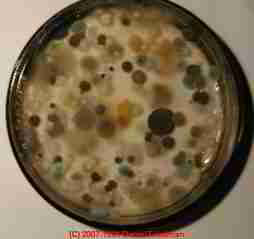 Guide to Using Mold Culture Plates or Settlement Plates to Collect Mold Samples
Guide to Using Mold Culture Plates or Settlement Plates to Collect Mold Samples
- POST a QUESTION or COMMENT about culture plates used for screening homes for mold contamination: home test kits for mold, reliability, alternatives, use.
Are mold culture tests accurate for screening buildings for mold contamination?
This article explains the use and accuracy of mold culture plates, settlement plates, and mold test kits based on cultures to collect mold test samples to screen buildings for harmful indoor mold. This study presents a summary and critique of some popular methods used to examine indoor air quality to test for presence or absence of problematic levels of toxic or allergenic mold or other bioaerosols. We describe and critique specific "testing" or "sampling" methods used to "test" buildings for mold in the course of a building investigation. The appropriateness of testing at all is discussed on this and other pages at our website.
InspectAPedia tolerates no conflicts of interest. We have no relationship with advertisers, products, or services discussed at this website.
- Daniel Friedman, Publisher/Editor/Author - See WHO ARE WE?
A Guide to Using Mold Cultures or Settlement Plates to "Test for Mold"
15th Annual North Carolina/South Carolina
Environmental Information Association Technical Conference
Myrtle Beach, SC
Daniel Friedman 23 September 2005, Updated 4/14/2009, 2/1/2010, 2/22/2012
In this article series discuss the validity of nearly all of the popular mold testing methods currently in use, pointing out the strengths and weakness of each approach to mold sampling in the indoor environment, beginning with air sampling for airborne mold levels indoors.
The use, accuracy, and reliability of mold culture test kits for screening buildings for mold contamination are discussed at MOLD CULTURE TEST KIT VALIDITY and MOLD CULTURE SAMPLING METHOD Also see Mold Culture Plate Test Errors.
Using Mold Cultures for Home Test Kits for Mold
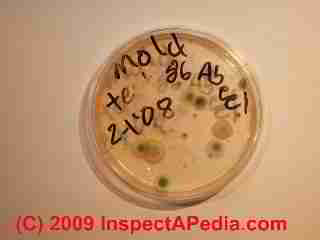 Mold cultures involve the collection of particles by air sampling pump, by
gravity settlement, or by lift from a surface using a swab or tape. Some
sampling equipment (Anderson™ spore traps) can collect spores directly into a
petri dish of culture medium, and are used for "viable spore sampling in air."
Mold cultures involve the collection of particles by air sampling pump, by
gravity settlement, or by lift from a surface using a swab or tape. Some
sampling equipment (Anderson™ spore traps) can collect spores directly into a
petri dish of culture medium, and are used for "viable spore sampling in air."
The sample by pump, gravity, tape or swab is in any case applied to one or more petrI dishes of culture media for incubation and subsequent examination of the growth product.
Mold Culturing is useful for genera speciation once you have collected a single or dominant sample whose importance (frequency in the building) you already know.
As a "home test kit" for the presence of problematic mold in a building this is an unreliable method, as we describe below at "shortcomings."
Mold Cultures are useful for:
- Identifying the genera/species of a mold which was not readily named by (faster, cheaper) light microscopy
- Identifying a problem genera to the species level for medical diagnostic purposes - we .e. pass this (possibly accurate) data along to your doctor if you're sick
- Distinguishing apparently similar outdoor mold counts from indoor mold counts of "look-alike" spores that may really be different genera/species
Seven Serious Shortcomings of Using Cultures to Test Buildings for the Presence of Toxic Mold
While this is an important tool which has a place in our arsenal, mold culturing is questionable as a means to characterize a mold risk in a building, particularly if it reports the absence of a mold problem. The objections listed below mean that field investigators must collect samples with some care and interpret lab reports with some caution.
- Roughly 90% of all molds on earth will not
grow on any culture under any condition.
Others are quite difficult to coax into growing on culture, even with careful methods. So if you buy a "home test kit" that uses a single culture plate, you're 90% wrong when you open the container. To be fair, it might be that many common indoor problem-molds will show up in certain cultures, but these numbers still hold. - The toxicity or allergenicity of a specific
mold (genera/species/strain) may vary widely depending on what it's growing on.
So even a "toxic" building mold might be low or non-toxic when growing on certain substances. Molds that grow on cultures may produce very different structures and have different medical characteristics than when growing in nature or in a building. - Cultures may name the wrong mold as "the
problem":
Cultures have a high risk of both missing the problematic spore and of indicating that some other spore is the dominant or problem in a building. For example, to speciate one of the more than 100 members of the Aspergillus genera requires culturing the sample on four different media, simultaneously, comparing subtle things like growth rate among morphologically similar species. We believe that virtually no lab uses that troublesome procedure outside of university research and medical laboratories. 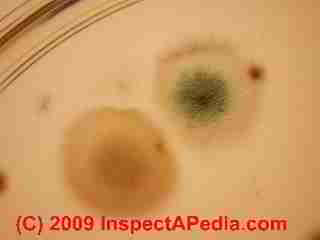 Settlement plate cultures (such as "home
test kits") usually rely on gravity,
Settlement plate cultures (such as "home
test kits") usually rely on gravity,
making any comparison of "spore counts" dead wrong - different spores are of different sizes and masses, and settle out of the air at different rates.
This over-states the presence of big heavy spores (like Stachybotrys chartarum) and under-states the presence of small light spores (like Aspergillus versicolor) in a given sample.
These small spores (2-3u) tend to stay airborne due to very slight indoor convection currents (e.g. heat from lighting and natural building stack effects).
Our lab photo shows two different mold colonies growing on a culture plate where individual spores settled out of the air onto this surface. Swab and tape samples for cultures may
collect the wrong mold.
Swab and tape samples for cultures may
collect the wrong mold.
Swab or tape samples used for culture for identification of what's on a surface have the same viable-non-viable question we have already raised. Everything depends on where you collected the swab or tape sample.
Moving a tape or swab over as little as one inch on a surface, and certainly moving it a few feet, can collect a completely different mold genera and species!
An "expert" should know what's probably representative of the building and should know where the important genera/species are likely to be growing.
Many investigators are quick to sample the highly-visible "black" mold on a surface and under-sample very important but hard to see light colored molds often found higher on a wall, for example, where the surface was less wet.- Cultures are probably not really being done
with full accuracy in some labs,
especially for Aspergillus: Culturing on one or even two media risks that the important genera/species in the sample does not grow at all on the medium, that it grows in a different form and is identified differently than it appears in the building, or that it is overgrown by another genera/species present which likes the culture more than the target species.
We have demonstrated this culture-media variation in a study we am pursuing about mold in tea. In a problem-tea sample cultured on the most commonly used culture media, MEA, the culture produced an overwhelming growth of Cladosporium sp., while a parallel culture (from the identical sample) made on DG-18 produced a single Cladosporium colony and grew an overwhelming collection of Aspergillus niger! 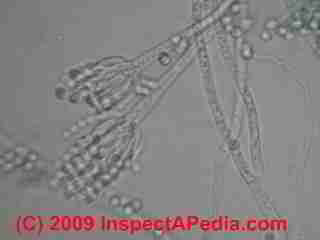 Non-viable spores, that don't grow on
culture may still be toxic
Non-viable spores, that don't grow on
culture may still be toxic
or allergenic particles which are a problem for some people exposed to them.
The Penicillium sp. at left was growing nicely in this culture sample, but we have no idea what other molds may have been present but that simply would not grow on this culture media even if they settled on or were placed onto the culture plate.
While we enjoy growing mold cultures in our lab (it makes for nice, photogenic mold colonies), it is less often useful than direct microscopic examination of a field-collected surface or vacuum sample. Without the added step of mold culturing, from a good surface sample using adhesive tape, a trained microscopist can identify mold genera and mold species as well in many cases.
In many instances, knowing the mold genera is enough to decide on a course of cleanup action without further expense.
For example, if we agree that there are no harmless Aspergillus species or Penicillium species that grow indoors, then for purposes of deciding on the need for remediation, only the size of the reservoir is important. P. notatum, used for making the drug Penicillin, has not to our knowledge been found growing on building materials.
For more discussion about mold cultures from settlement plates or swabs see MOLD CULTURE TEST KIT VALIDITY
Mold Photos in Petri Dishes - Not so Useful for Environmental Sampling and Mold Identification - What Level of Magnification is Needed to Identify Mold?
Also see MOLD in the PETRI DISH, PHOTOS
Why Can't I Find More Photos of Mold in Petri Dishes?
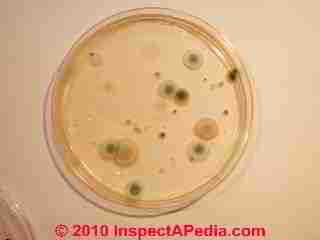
Question:
I was disappointed as there were no photos at all of petri dish examples of mold, and this is the way most of us out here will be testing for mold. So, how do I explore what mold I have in my petri dish test?
I have quarter sized discs of black/dark green mold growing. I did the airborne mold test.
My dog is always coughing and we are in pretty good health but feel a slight "tug" in my breathing, a slight heaviness in my lungs but not bad. I rent my apartment and my landlord has not been responsive to my concerns.
What can I do financially and health wise to explore my situation? Thanks for any tips!!! - Tony K
Reply: Microscopic Examination of Mold is Necessary for Reliable Identification
By Eye Examination of Culture Plates or Petri Dishes to Identify Mold?
The short answer is that you cannot reliably identify what mold is found in a petri dish simply by looking at some photos or color charts. Some mold genera or species might be ruled "out" or "possible" but expert examination of the sample using high-powered microscopy (or another definitive method) is needed. About what you can do about mold, take a look
at MOLD / ENVIRONMENTAL EXPERT, HIRE ? - for help in deciding if your situation honestly merits hiring an expert.
Then see MOLD ACTION GUIDE - WHAT TO DO ABOUT MOLD.

We do have some photos of mold in petri dishes posted just above and online, at other of our online articles about the role and limitations of using mold cultures as "home test kits" at the start of this page and in articles linked at the end of this one.
(You'll see there that what grows in culture is not necessarily the dominant or most significant mold that is present in a building.)
Traditionally, petri dish or culture plate photos were included in early mold taxonomy texts, where color and texture of mold growth at that scale assisted in identification of cultures of a known genera down to species level.
These were photos of mold cultured in laboratories where it is sometimes possible to separate a genera of mold (Aspergillus sp.) into species or groups of species (Aspergillus niger) based on color and other macro-characteristics.
In the closeup of a mold culture petri dish growth shown in our photo at above-right, high-powered microscopic examination was necessary to identify Penicillium sp [image] as one of the several mold genera growing among these green, gray,and dark gray colored mold colonies.
Sometimes we can make a pretty good guess about mold identification by the naked eye, if we see a particular color and texture of mold on a particular surface. For example this photo of mold on an orange [image] is showing what is most likely a species of Penicillium. But in general that's not reliable.
Stereoscopic Microscope Photos of Mold to Identify It?
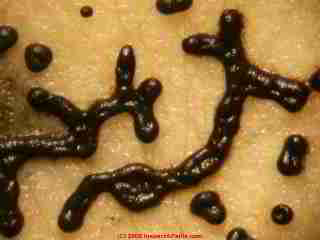
An "in-between" level of magnification, between using the naked eye to look at mold culture growing in a petri dish and using a high powered microscope is the use of a stereo microscope to magnify mold growth on surfaces such as on culture media in a petri dish.
For example, our stereoscopic microscope photo of Fuligo septica (left) is characteristic of that particular fungus.
Stereoscopic mold photos are often beautiful (like this stereoscopic photo of Stemonitis mold growth [image] structures taken in our lab) and may be helpful in identifying a mold genera. Here, for contrast, is a high power microscope photo of Stemonitis mold spores. [image]
But stereoscopic magnification is inadequate for reliable mold identification.
High Powered Microscopic Identification of Mold Spores
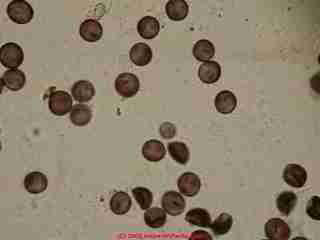
For environmental samples in which we need to identify mold genera/species or other particles, it's a different story.
As we operate a forensic lab that processes lots of materials including mold, collected by various means, we see that while petri dish photos are pretty, they are not diagnostic, nor can they be used alone for mold identification at that scale.
We need to examine mold structures and spores at 300x to 1200x to actually identify genera/species reliably.
See MOLD by MICROSCOPE for examples.
The Fuligo septic mold spores in our photo provide very different information than what we can get by eye looking at a mold culture plate or petri dish.
At MOLD "TESTING" vs. MOLD "PROBLEM IDENTIFICATION"
we discuss the question of what sorts of mold testing are most useful and which are actually diagnostic, giving information about the presence of a mold problem with enough information that you know what to do about it.
...
Continue reading at MOLD CULTURE TEST KIT VALIDITY or select a topic from the closely-related articles below, or see the complete ARTICLE INDEX.
Or see these
Recommended Articles
- MOLD CULTURE SAMPLING METHOD
- MOLD CULTURE PHOTOS
- MOLD CULTURE TEST ERRORS
- MOLD CULTURE TEST KIT VALIDITY
Suggested citation for this web page
MOLD CULTURE SAMPLING METHOD at InspectApedia.com - online encyclopedia of building & environmental inspection, testing, diagnosis, repair, & problem prevention advice.
Or see this
INDEX to RELATED ARTICLES: ARTICLE INDEX to MOLD CONTAMINATION & REMEDIATION
Or use the SEARCH BOX found below to Ask a Question or Search InspectApedia
Ask a Question or Search InspectApedia
Questions & answers or comments about culture plates used for screening homes for mold contamination: home test kits for mold, reliability, alternatives, use..
Try the search box just below, or if you prefer, post a question or comment in the Comments box below and we will respond promptly.
Search the InspectApedia website
Note: appearance of your Comment below may be delayed: if your comment contains an image, photograph, web link, or text that looks to the software as if it might be a web link, your posting will appear after it has been approved by a moderator. Apologies for the delay.
Only one image can be added per comment but you can post as many comments, and therefore images, as you like.
You will not receive a notification when a response to your question has been posted.
Please bookmark this page to make it easy for you to check back for our response.
IF above you see "Comment Form is loading comments..." then COMMENT BOX - countable.ca / bawkbox.com IS NOT WORKING.
In any case you are welcome to send an email directly to us at InspectApedia.com at editor@inspectApedia.com
We'll reply to you directly. Please help us help you by noting, in your email, the URL of the InspectApedia page where you wanted to comment.
Citations & References
In addition to any citations in the article above, a full list is available on request.
- Thanks to Tony K for discussing mold in petri dishes and indoor sampling or mold testing using cultures - July 2010.
- In addition to citations & references found in this article, see the research citations given at the end of the related articles found at our suggested
CONTINUE READING or RECOMMENDED ARTICLES.
- Carson, Dunlop & Associates Ltd., 120 Carlton Street Suite 407, Toronto ON M5A 4K2. Tel: (416) 964-9415 1-800-268-7070 Email: info@carsondunlop.com. Alan Carson is a past president of ASHI, the American Society of Home Inspectors.
Thanks to Alan Carson and Bob Dunlop, for permission for InspectAPedia to use text excerpts from The HOME REFERENCE BOOK - the Encyclopedia of Homes and to use illustrations from The ILLUSTRATED HOME .
Carson Dunlop Associates provides extensive home inspection education and report writing material. In gratitude we provide links to tsome Carson Dunlop Associates products and services.

